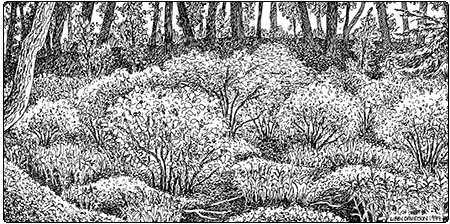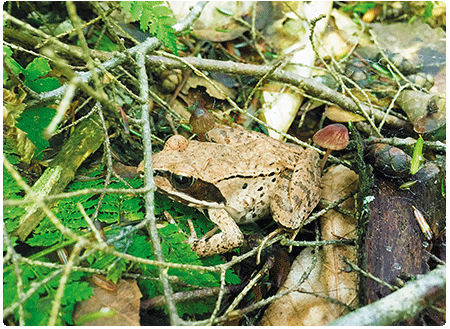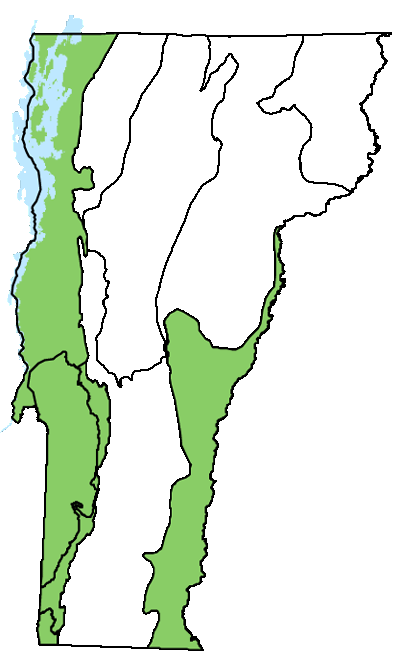Ecology and Physical Setting
Basin Shrub Swamps are found in the warmer regions of the state. It is not unusual to encounter these small swamps—green and wet oases—in unlikely locations within a dry landscape, surrounded by a forest of oak, hickory, or hemlock. An exploring naturalist can travel through acre after acre of dry forest, seemingly with no surface water anywhere around, only to suddenly discover one of these tiny wetlands.
This community is one of Vermont’s smallest wetland types; many are less than an acre in size. Basin Shrub Swamps occur in small, isolated depressions that are flooded in spring and where the water table drops slowly during the summer. While these are frequently bedrock-controlled depressions, Basin Shrub Swamps are also found in kettle holes, abandoned river oxbows, and other settings that result in a similar seasonal hydrologic fluctuation. Many Basin Shrub Swamps have small surface watersheds, and they lack inlet and outlet streams. The water in these swamps reflects the limited surface runoff and the level of the local water table.
The annual flooding prevents the establishment of trees in these swamps, distinguishing them from forested basin swamps. Accumulated organic matter decomposes when the swamps dry out in late summer, so deep organic soils are not typical in this community. There may be only shallow organic horizons over mineral soil.
Vegetation
Buttonbush, winterberry holly, and highbush blueberry are characteristic shrub species of these swamps. However, any basin may be dominated by only one or two of these. The duration of flooding has a strong influence on the vegetation. The wettest swamps, with a long hydroperiod, are dominated by flood-tolerant buttonbush and may have few other species. In swamps with a shorter hydroperiod, highbush blueberry and winterberry holly may be more abundant. Other shrub species can include meadowsweet, speckled alder, maleberry, spicebush, wild raisin, leatherleaf, and water willow. Most swamps dry out and support herb growth by midsummer, but herb cover is often sparse.
Wildlife Habitat

this wood frog.
Basin Shrub Swamps that have significant open water and that remain flooded for much of the spring and into the summer provide breeding habitat for amphibians that is functionally equivalent to that of Vernal Pools. Wood frogs, spotted salamanders, Jefferson’s salamanders, blue-spotted salamanders, and four-toed salamanders all breed in these basin swamps. As with Vernal Pools, the surrounding upland forest is important because these species spend most of their life cycle in the upland habitat and migrate from the forest to pools in early spring. These swamps may also host invertebrates, such as fairy shrimp, fingernail claws, snails, water fleas, and copepods, that are commonly found in Vernal Pools.
Basin Shrub Swamps are important for many species of wildlife in Vermont’s mostly forested upland landscape. In the spring, barred owls and raccoons hunt for salamanders and frogs in these basin swamps. Two species of bees are closely tied to host plants that often occur in Basin Shrub Swamps. Carolina andrena bee feeds on the pollen of heath-family shrubs, including highbush blueberry. The macropis bee Macropis nuda feeds on pollen and floral oils of the genus Lysimachia, which is represented in many Basin Shrub Swamps by swamp candles (Lysimachia terrestris). Spicebush can be abundant in these swamps in the warmer regions of Vermont. This fragrant shrub is the host plant for spicebush swallowtail caterpillars. This butterfly, rare in Vermont, is more abundant farther south, where its host plants—members of the laurel family—are more common.
Conservation Status and Management Considerations
This is a rare natural community type in Vermont. Several examples are on protected lands, but additional examples should be sought for conservation. Basin Shrub Swamps are highly susceptible to alterations of hydrology or water quality. Clearcutting, gravel mining, or other disturbances in the surrounding small watersheds can negatively impact the integrity of these swamps. For swamps that provide high-quality amphibian breeding habitat, the surrounding upland forest is essential for the amphibian life cycle and should be managed accordingly. See the section on Vernal Pools for additional information on management considerations around amphibian breeding pools.
Variants
- In some situations, it may be helpful to recognize a Buttonbush Basin Swamp variant and a Highbush Blueberry-Winterberry Holly Basin Swamp variant.
Related Communities
- Alder Swamps are usually found on organic soils and have more stable hydrologic regimes. They are commonly part of larger wetland complexes and not restricted to small isolated basins.
- Vernal Pool is a closely related community type. It has a similar hydrologic regime, but it lacks the well-developed shrub cover. Basin Shrub Swamps with patches of open water can provide amphibian and invertebrate habitat that is functionally equivalent to Vernal Pools.
- Lakeside Buttonbush Swamp has a similar hydrologic regime as a result of seasonal lake-level fluctuations. These swamps are usually part of larger lake-associated wetland complexes, and are found on deep organic soils.
Abundance/Distribution
Basin Shrub Swamps are known to occur in the Champlain Valley, Taconic Mountains, Vermont Valley, and Southern Vermont Piedmont. Similar communities are found in neighboring states.
Characteristic Plants
Shrubs
Common Species
Buttonbush – Cephalanthus occidentalis
Winterberry holly – Ilex verticillata
Highbush blueberry – Vaccinium corymbosum
Occasional to Locally Abundant Species
Meadowsweet – Spiraea alba
Speckled alder – Alnus incana
Water willow – Decodon verticillatus
Wild raisin – Viburnum nudum var. cassinoides
Maleberry – Lyonia ligustrina
Spicebush – Lindera benzoin
Leatherleaf – Chamaedaphne calyculata
Herbs
Common Species
Cinnamon fern – Osmundastrum cinnamomeum
Royal fern – Osmunda regalis
Northern bugleweed – Lycopus uniflorus
Blue flag – Iris versicolor
Woolgrass – Scirpus cyperinus
Occasional to Locally Abundant Species
Sensitive fern – Onoclea sensibilis
Marsh fern – Thelypteris palustris
Water parsnip – Sium suave
Nodding beggar’s-ticks – Bidens cernua
Bulb-bearing water hemlock – Cicuta bulbifera
Swamp candles – Lysimachia terrestris
Invasive Non-native Plants
Yellow iris – Iris pseudacorus
Glossy buckthorn – Frangula alnus
Rare and Uncommon Plants
Floating mannagrass – Glyceria septentrionalis
Barbed-bristle bulrush – Scirpus ancistrochaetus
Associated Animals
Wood frog – Lithobates sylvaticus
Gray treefrog – Hyla versicolor
Spotted salamander – Ambystoma maculatum
Spring peeper – Pseudacris crucifer
Raccoon – Procyon lotor
Star-nosed mole – Condylura cristata
Barred owl – Strix varia
Carolina andrena bee – Andrena carolina
Macropis bee – Macropis nuda
Rare and Uncommon Animals
Jefferson salamander – Ambystoma jeffersonianum
Blue-spotted salamander – Ambystoma laterale
Four-toed salamander – Hemidactylium scutatum
Spicebush swallowtail – Papilio troilus
Places to Visit
Pond Woods Wildlife Management Area, Benson and Orwell, Vermont Fish and Wildlife Department
